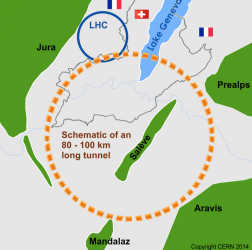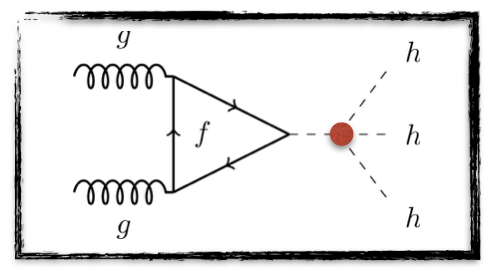Higgs bosons, beauties, taus and other beasts - particle physics again around on Steemit!
It is a long time I have not written anything here. Actually, almost three months…
Despite what it seems, I have not run away from Steemit. My work has been in fact very demanding in terms of time. To make a long story short, I was in a hurry of finishing a bunch of scientific articles (which I may or may not speak about soon), I traveled the world very heavily for lectures and conferences (and hence visited three continents in less than three months ^^), I was overwhelmed with my administrative burden and I had finally very little time for myself and my family…
That is probably a typical life for a scientist… And you can clearly see it is hard to insert Steemit in such a picture.
Anyhow, here I am! Back, and I will try to be more present. The sky is not yet totally clear again, but at least I can hope to write a little bit every week and answer posts.
THIS POST: WHAT A TITLE?!
How to make a come back noticed? Maybe with a crazy title! The title of this post is not random and I hope you will get into it by the end of this post.
The title of my post hence contains several keywords related to one of the articles that collaborators and I wrote during my Steemit absence: this article that has just been accepted for publication in Physics Letters B. By the way, open access is very important for me, and the article will be available for free to anyone forever. CERN and many high-energy physics institutes are actually paying for that (this is the so-called SCOAP-3 agreement.

[image credits: the particle zoo]
But what is this article is about? We investigated the production of Higgs bosons at a future circular collider that could exist in 30-40 years. Neither one Higgs boson (that is too standard and thus kind of boring) nor two Higgs bosons (that can be observed at the LHC), but three of them.
The study of the production of three Higgs bosons is very important, as it may give hints about one of the few parameters of the Standard Model of particle physics that the LHC will not be able to say anything about with direct measurements.
It consists thus of a good motivation for the building of the next particle physics collider experiments. We indeed would like to get information about all the Standard Model parameters to better understand how nature works at the microscopic level, and to be sure that there is not any novel phenomenon hidden in there.
TOWARDS A SUPER LARGE HADRONIC COLLIDER

[image credits: CERN]
In this older post of mine, I was discussing one of the future options for particle physics: a super large hadronic collider of 100km of circumference. It is a kind of LHC machine, but much larger. Two potential locations are currently being discussed for this future machine, one at CERN (using the LHC as a pre-accelerator) and one in China.
The studies that are being done today are those that will help the high-energy physics community to decide whether we should build this machine and what could be expected in terms of physics goals.
This is what my triple-Higgs article is about. Showing what can be expected with respect to the knowledge of the Higgs sector of the Standard Model.
The Standard Model includes one parameter connected to the strength of the interactions between four Higgs bosons. There is no way the LHC can measure this parameter directly and in 30 years, we will only know it through indirect measurement with a very limited precision. We need hence a new machine!
TRIPLE HIGGS SEARCHES AT A FUTURE COLLIDER
But what about this quartic Higgs self-interaction strength? Physics-wise, this parameters is related to lot of phenomena. For instance, it is connected to how the masses of the particles are generated, to the matter-antimatter asymmetry in the universe, etc.
This parameter plays a direct role in the production of three Higgs bosons, as illustrated on the representative Feynman diagram shown on the left. Two gluons (on the left part of the diagram), that are constituents of the colliding protons, fuse into three Higgs bosons (on the right of the diagram) via a closed loop of fermions (the solid triangle) and another intermediate virtual Higgs boson (the first horizontal dashed line). We observe a quartic Higgs interaction involved (the red dot), which shows that this process is sensitive to it.
All former studies of this process were considering an easy signature of the three Higgs system made of photons and jets of strongly interacting particles originating from a b-quark, or b-jets. This is expected to be the best channel as the signal is clean and the background is small. The results of these studies (see for instance here) were showing that we will be able to access the Higgs quartic coupling if its value is much larger than the Standard Model one. However, a value compatible with the Standard Model will be barely noticeable.
This was a bit depressing. However, in our new study, we used a signature made of b-jets and tau leptons. As the b-quark is also known as beauty, now you can understand the title.
Although the used tau-b signature was thought to be hopeless in terms of discoveries, we made use of modern analysis techniques to resurrect it. And we shown that… a value compatible with the Standard Model will be barely noticeable.
And that is actually a good news: statistics does the rest: combining two barely noticeable results… becomes noticeable! In crude words, 2σ plus 2σ equals to 3σ, and 3σ is enough to claim for hints of observing the signal!
Hints are hence potentially there, just waiting for being discovered!
TAKE HOME MESSAGE AND REFERENCES
With this post, I presented one of my own research work on the potential of future collider experiments in particle physics. We have investigated a novel signature of the production of three Higgs bosons and studied its expectation in terms of a discovery. The results, once combined with previous studies, are promising, and consist thus in one strong motivation *(among others) for building a future machine to carry out particle physics experiments.

IT HAS BEEN A LONG TIME IN DEED AND I'm GLAD TO READ MORE FROM YOU, ESPECIALLY WHEN IT IS DIRECTLY FROM YOUR STUDIES, AWESOME WORK!!!
THANKS A BUNCH FOR SHARING THIS SCIENCE NEWS WITH US HERE ON STEEMIT.COM. ALL FOR ONE AND ONE FOR ALL! NAMASTE :)
Indeed. a very long time. You know. work, life and all that bring us here and there, here and there being sometimes far from Steemit ^^
I am happy to see a lot of nice people being still here, you included :)
Your presence is both welcome and very much needed around these parts my friend. It is good to read your writing again. Congratulations on the newly accepted publication!
Me as well.
Unfortunately, mentalities take time to change...
They never will with out people preferring open access :)
It is the story of the small snow ball becoming an avalanche :)
Thanks for taking the time to write this.
you reckon supersymmetry will show up in the LHC in future?
You are welcome. It is impossible to answer your question actually. Supersymmetry is a vast class of theories (I wrote about it long ago, here) and there are many ways to realize a viable model.
In some realizations, the new particles are not to difficult to detect and should show up at the LHC in the next few years. In some others, this is more tricky and the LHC will not be able to help. And finally, supersymmetry may just not be there at all, or at a much higher energy not reachable today.
What is important is to look for supersymmetry in all possible ways, in the same manner as we look for any other phenomena. In this sense, whatever nature is preparing for us, we will be ready and we will detect it.
A nice feature of supersymmetry is that it consists in a very nice playground for many new physics theories. The phenomena that are predicted also occur in other models, and we can then easily reinterpret supersymmetry search results to constrain many other theoretical framework.
I actually was a supersymmetry person in my early days. I am still working on supersymmetry, but I am also working on many other things at the same time! It is important to try as many options as possible :)
Thank you. I have a deep curiosity about these things but unfortunately i do not have a science background, and it's amazing to me how one is able to access all the literature from anywhere in the world and even directly interact with scientists, all thanks to the Internet!
And for particle physics, I would even say: open access. Most particle physics articles are actually open access, and if not, free versions exist on the arxiv. That is something that is very special of our field and that I am very proud of (although I was not involved at all in those decisions).
welcome back here. great to see this kind of research and its future expectations. keep up the good work. i will try to read the paper itself later tonight, but i fear it will be beyond me.
Do not hesitate to try. It is however rather concise (that is a letter at the end of the day) so that details may be missing. In any case, do not hesitate to ask me anything :)
In read somewhere that it is still in discussion if the upgrade will be a new ring as you described or a linear accelerator, depending on results of current research/computer simulations.
Does your post/findings tilt that towards ring or why don't I read anything about the linear accelerator here?
For the moment, there are actually several options for what concern high-energy colliders:
Which option is better is very hard to tell today. A decision should be made in 2018. For the moment, it is time to evaluate the physics prospects of all of them, the timeline, the costs, etc... and we also wait for inputs from the LHC of course.
Welcome back. :-)
Thanks a lot! :)
Hi @lemouth, welcome back!!
Thanks! :)
I am so glad you are back!
Thanks :)
interesting
nice....you deserve resteem and upvote...